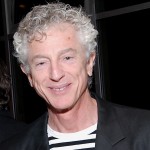Beijing & Guangzhou
With a prestigious grant from the Asian Cultural Council, Hammer adjunct curator James Elaine moved to China in April 2008 to seek out emerging artists within China and throughout Asia. This blog provides a fascinating insight into Jamie’s travels and the art world in China.
Beijing & Guangzhou
In just over one weeks time eight different cities in China and Asia hosted at least five contemporary art fairs, 4 biennials, and 3 triennials; Beijing, Guangzhou, Shanghai, Nanjing, Gwangzhu, Yokohama, Taipei, and Singapore.
September 5th I attended the opening of one of Beijing’s two annual art fairs, Art Beijing, which had added for the first time a photo fair in a building adjacent to it. Six a.m. the next morning I began my mini marathon of the other September Chinese art fairs, bi and triennials. First stop was in Guangdong for the Guangzhou Triennial. They had two openings in two different locations for the exhibition. I was taken from the airport to a hotel and a waiting shuttle bus loaded with other curators, given some hot noodles to eat, and driven for another hour to some distant part of the city to attend the afternoon opening of the Guangzhou Triennial. This was my first trip to Guangzhou and the bus ride was fascinating. We winded through lush green city streets full of thousands and thousands of people shopping, working, cooking, eating, yelling… The shops had no doors so the merchandise and the owner’s activities spilled out onto the sidewalks. There was a fluid and ordered chaos to it all that was beautiful to watch. I thought of my Chinese artist friends who earlier this year visited Los Angeles and all surprisingly commented on how few people there are in LA. Actually, you don’t see many people in LA what you see are buildings and cars. But in China everywhere you go people dominate the landscape. During the trip it began to rain and as we reached our destination it was a downpour.
The Triennial exhibition, “Farewell to Post Colonialism,” was presented in two venues, the Guangdong Museum of Art and it’s satellite location, Rem Koolhaas designed Time Museum. 181 artists from over 40 countries were included. The basic concept for the show is a “revisiting and restarting” of the post colonial “intellectual tradition” which the curators believe has become institutionalized as an ideological concept and lost its edge as a critical tool. This current condition of “political correctness” they state has hindered “the emergence of artistic creativity and fresh theoretical interface.” The first ceremony took place at the Time Museum, which unfortunately, due to lack of funds was still under construction during the opening. The lobby was a ground floor open air space (no windows or doors yet) and people packed themselves in to avoid the torrential downpour outside. I saw Los Angles artist Simon Leung there who had worked up to the last minute installing his work “Squatting Project/Guangzhou,” but it still was not completed. Flooding on the ground floor and the slow building construction had hampered his installation schedule for over a week. The museum is housed on the 14th and 19th floors of a high-rise building but there is only one elevator and no stairs. There was loose electrical wiring still hanging from the ceiling and jutting out of the walls. It felt like we were on a construction site and I wondered if we would be issued hard hats to enter the exhibition areas. Once you made it off the crowded elevator and stepped out into the top floor the first thing you noticed was a large area of the floor where buckets had been placed amongst the art to catch water from a leaking ceiling. Some rooms in the museum, especially the enclosed video rooms, were uninhabitable because the fresh concrete and wallboards were off gassing. It only took a few seconds standing in these rooms before your eyes were burning so badly that it became impossible to see anything including the art. This is not ideal viewing or exhibiting conditions to say the least, but to be honest I loved the experience as a whole. It was exciting and vital and mirrored the vigor and chaos of the world outside of the museum. I was also moved by the organizers and curators will to persist even in the face of the lack of money to complete the project on time.
The second and main part of the Triennial, at the Guangdong Museum of Art, was less chaotic but lacked the potential of the Time Museum for surprises. There was good work to be seen, including the young Chinese artist Jia Aili’s untitled large scale painting installation, but overall the exhibition was too overcrowded. Annually there are many international art fairs, biennials, triennials, survey exhibitions and at some point they all begin to look the same. The locations and programming sometimes are the defining moments and are reasons in themselves to attend. I loved Guangzhou and time permitting will return to see the Triennial in less chaotic circumstances, and visit galleries and the city again.
Next:
Shanghai
Nanjing
Hangzhou





